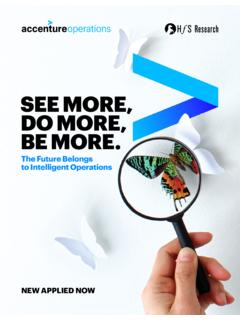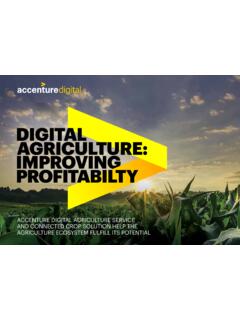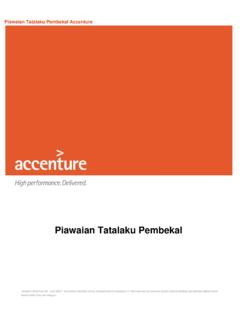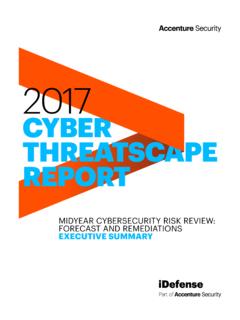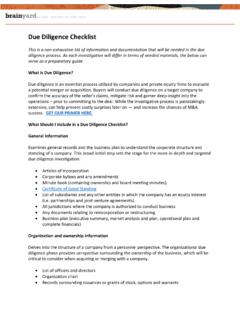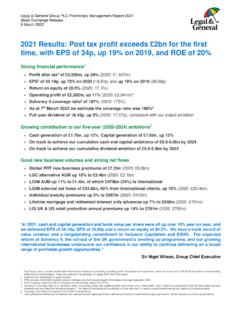Transcription of The Green Behind the Cloud - Accenture
1 1 THE Green Behind THE CLOUDThe Green Behind the cloud2 THE Green Behind THE CLOUDC loud has moved from nice-to-have to must-have . But not all approaches to Cloud migration are equal. Cloud migration can deliver a double helix effect of shareholder and stakeholder value simultaneously reducing costs and carbon emissions if approached from a sustainability perspective. Leading to a greener planet and a boost in THE Green Behind THE CLOUDP avel PonomarevPeter LacyPaul DaughertyKishore DurgSenior Managing Director Lead Intelligent Cloud & Infrastructure Accenture Technology Kishore is the Growth and Strategy Lead for Accenture Technology Services where he helps in Ventures and Acquisitions, Technology strategy and Strategic Growth Managing Director European Lead & Global Sustainability Lead Accenture StrategyPeter advises leaders of Fortune 500 companies on strategies related to growth, technology, innovation and sustainability.
2 Principal Director Sustainability, Accenture StrategyPavel leads the North American Sustainability Strategy practice and has deep expertise in technology and Chief Executive Technology, and CTO, AccenturePaul Daugherty is Accenture s chief technology and innovation officer and leads the company s Technology Innovation and Ecosystem THE Green Behind THE CLOUD3 THE Green Behind THE CLOUDF orecast for cloudThe business forecast is for more and more Cloud with a chance of significant and carbon. With the proliferation of data and devices, public Cloud will only gather strength. Every business will become a Cloud -first this: The number of large-scale data centers is increasing by 14% each year1 and public Cloud spend will rise by 17% between Some analysts estimate that of the United States IT spend is dedicated to Cloud , with China at and catching up This double-digit growth comes with a price.
3 Global data center electricity consumption is nearly equivalent to the annual consumption of the country of ,5 However, by pursuing a Green approach, our Accenture analysis suggests migrations to the public Cloud can reduce global carbon (CO2) emissions by 59 million tons of CO2 per year. This represents a reduction in total IT emissions and equates to taking 22 million cars off the road. This magnitude of reduction can go a long way in meeting climate change commitments, particularly for data intensive THE Green Behind THE CLOUD4 THE Green Behind THE CLOUDFrom Accenture s experience supporting Cloud migrations for hundreds of clients, sustainable Cloud positions companies to deliver on financial targets. We ve seen up to 30-40% total cost of ownership (TCO) savings. Drivers like greater workload flexibility, better server utilization rates, and more energy-efficient infrastructure all make public clouds more cost efficient than enterprise-owned data peers through responsible business practices: Based on Accenture research, between 2013 2019, companies with consistently high ratings for environmental, social and governance (ESG) performance enjoyed higher operating margins than low ESG performers over the same period.
4 High performers generated higher annual total returns to s h a re h o l d e rs , outperforming peers by Over the past several months, when global markets have faced tremendous pressures and volatility, companies with high ESG scores have continued to outperform, experiencing a cumulative relative return higher than bottom performers and facing lower Accenture , we practice what we preach: Today we run a full 95% of our applications on the Cloud . The migration led to $ million in benefits after the third year. Another $3 million in annualized costs were saved by right-sizing service THE Green Behind THE CLOUD5 THE Green Behind THE CLOUDAs importantly, Cloud migrations also unlock new opportunities like clean energy transitions enabled by Cloud -based geographic analyses, material waste reductions from better data insights, and targeted medical R&D as a result of faster analytics of Terms SUSTAINABLE Cloud A technology platform that enables organizations to tap on-demand public, private or hybrid computing capabilities through virtual hardware, software and services.
5 Sustainable Cloud focuses on the environmentally friendly operation and use of Cloud services through a proactive approach to lowering carbon emissions and unlocking new responsible applications of Cloud technology. PUBLIC Cloud Computing services provided by third-parties and offered over the public Internet. They are typically available for purchase INDUSTRIAL REVOLUTION (4IR) A term coined by Klaus Schwab, Founder and Executive Chairman of the World Economic Forum, in his book, The Fourth Industrial Revolution . 4IR technologies are characterized by a range of new technologies that are fusing the physical, digital and biological APPLICATIONS Designed to take full advantage of on-demand computing, higher asset utilization rates, and multi-tenant structures that allow multiple customers to be served with one application ECONOMY The departure from traditional take, make, waste production and consumption systems to a system whereby resources are kept in use for as long as possible, the maximum value is extracted from them whilst in use, then products and materials are recovered and regenerated at the end of each as the future of business: Companies have historically driven financial, security, and agility benefits through Cloud , but sustainability is becoming an imperative.
6 According to the latest UNGC- Accenture Strategy CEO Study, more than 99% of CEOs from large companies now agree that sustainability issues are important to the future success of their businesses. Two-thirds view fourth industrial revolution (4IR) technologies as a critical factor for accelerating socioeconomic impact. 59% of CEOs say they are deploying low-carbon and renewable energy across their operations today while 44% see a net-zero future for their company in the next ten THE Green Behind THE CLOUD6 THE Green Behind THE CLOUDT oward greener cloudNot all Cloud migration approaches are created equal when it comes to sustainability and one size certainly does not fit all. What do we mean by that? The range of benefits possible depend on a company s focus around three things:010203 Select with purposeBuild with ambitionInnovate further7 THE Green Behind THE CLOUD7 THE Green Behind THE CLOUDS elect with purpose01 The first step towards a sustainable Cloud -first journey begins with selecting a carbon-thoughtful provider.
7 Cloud providers set different corporate commitments towards sustainability, which in turn determine how they plan, build, power, operate, and retire their data emissions can differ widely across providers even though many providers have focused on driving down energy consumption to standard benchmarks. Differences arise from varying ranges of corporate investments in renewable energy generation, the reusability and recyclability of data center hardware, and advanced analytics for better management of asset operations. And Cloud customer-facing services like transparent real-time reporting of associated carbon emissions can help track actuals against sustainability to consider when selecting a public Cloud provider:Carbon neutral or carbon negative corporate goals of the providerSource of electricity, the renewable power mix, and the Cloud provider s support for developing new renewable generation sources rather than purchasing carbon offsetsDirect match of energy usage with 100% renewable energy purchases, ideally in real-time (See Google case study on next page)Commitment to the most energy efficient underlying infrastructure, including optimized network & servers, smart construction, state-of-the-art cooling, and responsible water management (See Amazon Web Services case study on next page)Customer-facing services like carbon calculators or granular Cloud lifecycle emissions reporting to help companies monitor their Cloud footprint (See Microsoft case study on next page)
8 Circular value chains of Cloud provider s hardware8 THE Green Behind THE CLOUD8 THE Green Behind THE CLOUDM icrosoft, carbon neutral since 2012, has committed to shifting its data centers to 100% supply of renewable energy by 2025 through power purchase agreements (PPAs). The company recently launched its ambition to be carbon negative by 2030 and by 2050 to remove all carbon emitted by the company since Microsoft Azure s customers can access a carbon calculator that tracks emissions associated with their own workload on the Microsoft AzureGoogle currently utilizes a carbon-intelligent computing platform that shifts timing of non-urgent data center workloads to when low-carbon sources of energy are most plentiful. The company has also been matching 100% of its annual energy usage with renewables since The company has a bold commitment to operate its data centers carbon-free 24/7 by 2030, rather than rely on annual direct energy matches.
9 In 2020, Google became the first company to achieve a zero lifetime net carbon footprint, meaning the company has eliminated its entire legacy operational carbon Cloud PlatformAWS s expansive infrastructure is times more energy efficient compared to median US enterprise data centers, largely due to efficient servers and high capacity utilization The company s water-cooled facilities actively measure water efficiency and select conservation options in the context of regional climate patterns and local Web Services (AWS) Cloud PROVIDER CASE STUDIES9 THE Green Behind THE CLOUDB uild with ambition02 The journey toward a sustainable Cloud involves three ambition levels: infrastructure as a service (IaaS also referred to as lift-and-shift ) migrations (bronze level) without major redesign, application of sustainable software engineering practices (silver level), and application optimization for the fabric of the Cloud (gold level).
10 IaaS migrations can reduce carbon emissions by more than 84% compared with conventional infrastructure. Reductions can be pushed even higher by up to a whopping 98% by designing applications specifically for the Cloud . The graphic below indicates the incremental levels of carbon reduction that can be achieved the greater the ambition, the greater the reduction in carbon carbon emissions (estimated ranges based on Accenture research and analysis) Cloud Footprint10-20%Power & Cooling EfficiencyCompute UtilizationCloud-Native Application ArchitectureCarbon Free Energy &HW Circular EconomyCloud FootprintCloud-basedSustainability Use Cases15-20%5-10%35-45%LowCO2 IntensityHighHardware Efficiency10-15%Sustainable SoftwareEngineering5-10%On-Premise Enterprise IT-Footprint10 THE Green Behind THE CLOUD10 THE Green Behind THE CLOUDIaaS migrations involve migrating applications from enterprise-owned to Cloud without major redesigns of applications or workflows.

